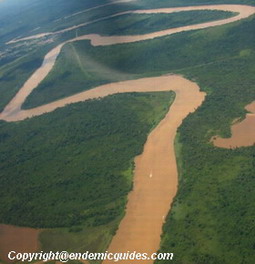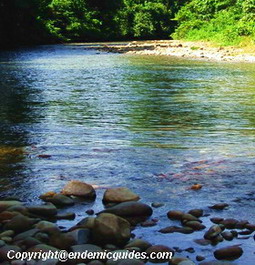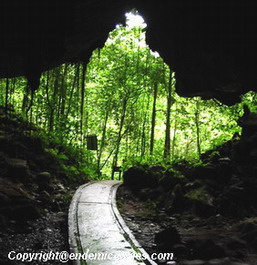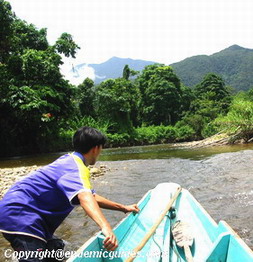|
Welcome To
GUNUNG MULU NP
PAGE - SARAWAK
|
Introduction and History
The Gunung Mulu National Park is situated close to the
southern border of Brunei with Malaysia, about 100km
east-southeast of the town of Miri and 100km due south of Bandar
Seri Begawan, Brunei. It lies between the headwaters of the
Tutuh River, a tributary of the Baram River and covers 544km2,
ranging in elevation from 50 meters to 2,376 meters. The park
is important for its high biodiversity and unique karst
(limestone) features. Besides that, it contains seventeen
vegetation zones, exhibiting some 3,500 species of vascular
plants. It was first constituted on 3 October 1974 but only
opened to public in 1985.
The climate here is determined by the Indo-Australian
monsoon system. From December to March, it will encounter the
wet northeast monsoon and the slightly drier southwest monsoon
from May to October. Generally, rainfall is high here with
seasonal averages ranging from 4,000 to 5,000mm. Temperatures
in the Melinau lowlands range from 23ºC to 26ºC and at Gunung
Mulu between 14ºC to 18ºC.

The Park has three mountains, Gunung Mulu 2,376m, Gunung Api
1,750m and Gunung Benarat 1,585m. Many of Mulu’s attractions
lie deep below the surface. Hidden right underneath the
forested slopes of these mountains is one of the largest
limestone cave systems in the world. The Park has a number of
world record-breaking caves such as the Sarawak Chamber -
largest cave chamber in the world, Deer Cave - largest cave
passage and the Clearwater Cave - longest cave in Southeast
Asia. There are at least 300km more of explored caves, which
provides a spectacular sight. These caves are also home to
millions of cave swiftlets and bats.
The oldest of Mulu's caves started to form about 5 million
years ago when sideways earth movements resulted in the
formation of both limestone and sandstone mountains, lying side
by side. Millions of years of heavy rain and the action of
rivers and running water carved out the vast subterranean system
that exists today. The weathering process still continues;
dripping water creates new rock features, limestone is slowly
worn away, and underground rivers carve and sculpt the caves,
transporting limestone debris to the cave mouth or
redistributing it within the system.

Flora and Fauna
There are seventeen vegetation zones, which have been
recognized, and over 3,500 plant species recorded and 1,500
flowering plants identified.
Gunung Massive, lowland dipterocarp forest occurs up to an
altitude of 800 meters and 284 tree species have been recorded.
Between 800 meters to 1,200 meters, Quercus Subsericea dominates
the lower montane forest. Upper motane forest displaces between
1,200 meters to 2,177 meters where small tree and shrub layer
can be found like Rhododendron and Vaccinium and some other
pitcher plants like Nepenthes lowii, N. tentaculata and
N.muluensis.

Limestone forest occurs on the Melinau Limestone Formation,
which includes limestone forest; limestone cliff vegetation,
lowland limestone montane forest, upper motane limestone forest
and limestone cave vegetation. Many endemic calcerous species
are represented in this area; the limestone flora is one of the
most diverse and best preserved in Southeast Asia.
The alluvial plain in the park comprises of lowland alluvial
forest, tropical heath forest, peat swamp and riparian forest.
It is the most complex vegetation formation in the park. Some
emergent species attain a height of forty meters, with maximum
girths of 250m.
Gunung Mulu
National Park is also considered to be one of the richest sites
in the world for palms, with approximately 111 species and 20
genera recorded. These are Wild sago palm, which occurs on the
steep slopes of Gunung Mulu; Iguanura melinauensis and Licuala
Lanata are endemic to the alluvial plain; Calamus Neilsonii and
Salacca are endemic to the limestone.
About 1,700 species of liverworts and mosses have been
recorded. Examples of endemic mosses to the park include
Hypnodendron beccarii and H. vitiense. The very rare bogmoss can
also be found in rain gullies in the high forest. There are also
a great number of spore producing plants, occurring in the park.
To date 442 species have been identified, many of which are
ferns. In addition 4,000 species of fungi have been recorded.

Fauna species, including 81 mammalian species were found.
Important mammal species such as the Malayan Pangolin and 2
species of endemic Borneo squirrels; the tufted ground squirrel
and the plain pigmy squirrel have been identified in the park.
The Savi pigmy shrew, the smallest mammal in the world, weighing
only 2 grams is also found. Other than that, 28 species of bats
have been recorded, which is one of the highest numbers in South
East Asia. The largest colonies of free tailed bats,
wrinkle-lipped bats can be found in Deer Cave including 12
different bat species, the Lesser tailless round leaf and the
Orange-tube nosed bat that have not been seen anywhere else in
Borneo.
The Park also recorded 270 bird species where out of the 29
endemic Borneo species, 26 have been recorded. There are 8 of
Borneo’s hornbill species have been identified including the
wrinkled hornbill. Other species include Bulwer’s Pheasant,
crested fire back pheasant, Storm’s stork, and the Bamboo muni
which is endemic to Borneo and has only been found in Mulu and
Kinabalu

A total number of 25 snake species have been identified.
This include regal python, reed snake and poisonous snakes like
the banded-coral snake, the red headed krait and the
white-spotted cat snake. Two-thirds of all known amphibian
species occurring in Borneo can be found at the nominated site,
including Wallace’s flying frog and the significance is the
Philautus that only breeds in the fluid of the pitcher plant and
27 species of lizard have been identified.
Others existed in the park are 76 species of amphibians and
48 species of fish.
Continue Page 2 >>
|